Last Updated on: 11th October 2024, 11:14 am
Focusing on goalkeeper training in your team sessions isn’t always easy with so many players around. Of course, it’s important not to overlook your keeper. You don’t want them just standing in goal during your other drills, so we’ve compiled a few tips and drills to make goalkeeper training easier.
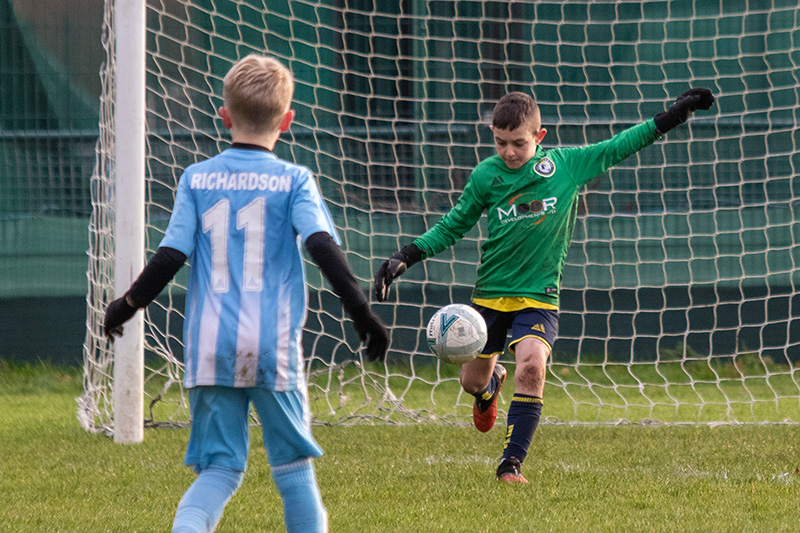
What makes a good goalkeeper?
As well as technical abilities, certain qualities help when playing in goal. For example, height will definitely be an advantage for keepers. Other things to look out for include:
- Agility
- Flexibility
- Quick reactions
- Courage
- A sense of position
These qualities will be helpful for any player who wants to progress in this position.
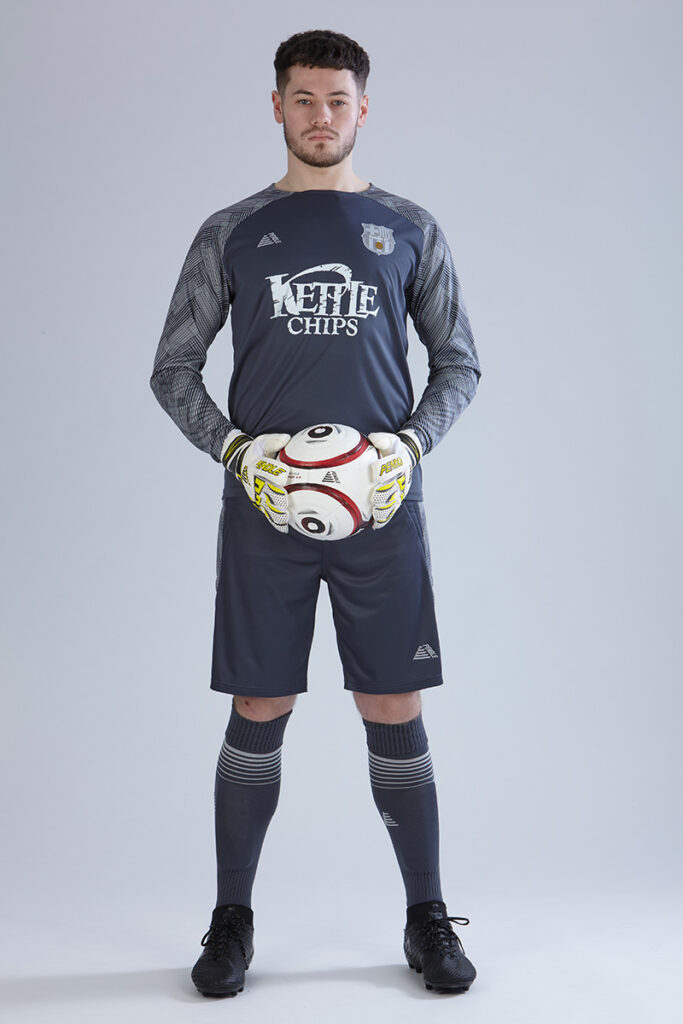
Goalkeeper Safety
It’s recommended that goalkeepers train in protective clothing to prevent any injuries from occurring. Ideally, they should wear padded kits and goalkeeper gloves. This will ensure that their body is protected when they throw themselves in the path of a ball.
Our range of goalkeeper kits includes padding that doesn’t restrict their movement on the pitch. Get some of our goalkeeper shirts with padded arms and match them with our padded shorts and bottoms. Grab a pair of goalkeeper gloves and they’ll be ready for whatever you throw at them.
Goalkeeper Training
Goalkeeping is one of the most important positions on the football pitch. A good goalkeeper prevents the opposition from scoring. A great one will also inspire the defence and contribute to the attack. They’ll need the confidence to make quick decisions and the courage to carry out them. Your training drills should replicate in-game situations to prepare them for whatever might happen.
Some of the most important areas to focus on are:
- Coordination: include this training at the start of the session when your keeper isn’t tired.
- Speed: keepers need to be fast to follow the ball.
- Plyometrics: your goalkeepers need to have power when jumping.
- Diving: your keepers must know how to dive properly to increase success and prevent injuries.
- Distribution: your keeper needs to be comfortable using both their hands and feet for distribution.
Other aspects of the position need to be incorporated but getting these skills strong will start them off strong and give room for further development.
Attack and Defence
Good goalkeepers assist with both defensive and offensive play. Obviously, they are a huge part of the team’s defence. As such, your keeper should be great at communicating, so they can organise the defensive line and offer clear instructions. Your keeper should understand the team’s strategy and be able to offer guidance and maintain order during high-pressure situations.
A great goalkeeper needs an awareness of their role in the team’s attacking play because effective distribution can help initiate counterattacks. Your keeper will need to be comfortable with:
- Throwing long and short balls
- Kicking accurate goal kicks
- Delivering precise passes
They must know when to kick or throw the ball because it will reduce the risk of errors and help initiate offensive plays. Your team will be weaker if your keepers aren’t great at passing with their feet.
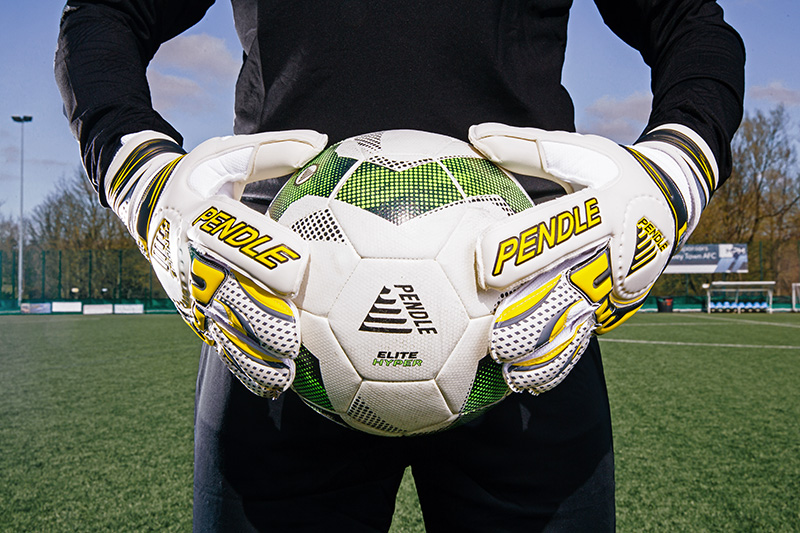
Mental Training
All players need to be prepared to deal with the emotional highs and lows of the game but there can be a lot of pressure associated with goalkeeping. Imagine that you saved every single shot for most of the match and then missed one at the end. It could feel like your hard work was overwritten by a single mistake. Not only is it important to prepare your keeper for dealing with the pressure but you need to help them focus on the positives.
Essential Equipment for Goalkeeper Training
Before diving into the drills, let’s take a look at the basic equipment you’ll need:
- Goalkeeper Gloves: Proper gloves are vital for grip and protection.
- Cones or markers: Use these for marking zones and guiding footwork drills.
- Agility Ladder: Helps in improving foot speed and coordination.
- Rebounder: Perfect for practicing quick reactions and shot-stopping.
- Footballs: The size will depend on the age of your players.
- Poles or Mannequins: Useful for simulating opponents or creating obstacles.
Check out our full range of training equipment so you have everything you need.
Goalkeeper Training Drills
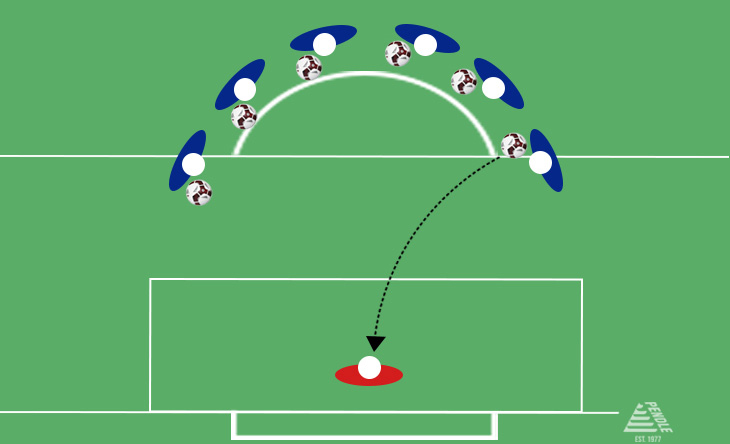
Clock Shooting
Equipment: One ball for every player, goal.
Set-Up: Players stand in a semicircle around the penalty area with the goalkeeper standing in front of the goal.
Instructions:
- Number the players in the semicircle from alternate ends inwards (see fig. above)
- Shout a number and that player shoots.
- The goalkeeper positions themselves for the shot.
- Go through all of the numbers.
- Make sure the keeper has enough time to position themselves between each shot.
Coaching Points:
- The keeper needs to position themselves correctly to narrow the angle for each shot.
- Make sure the keeper is in the ready position before each shot is taken.
- The keeper needs to pick the best way to stop the ball for each shot.
- Your keeper must be ready to make a second save if the first does not succeed.
Progression:
- Shooters increase the speed at which they release their shots.
- Two players on opposite sides of the penalty area work together. One shoots and the other rebounds for any shots that rebound off and away from the keeper.
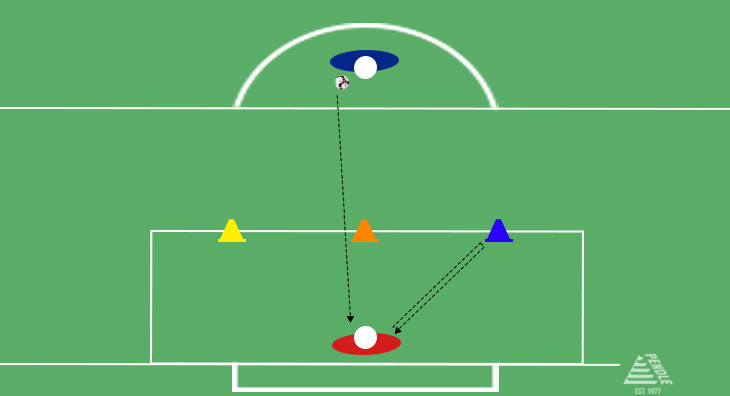
Three Cone Drill
Equipment: Three cones, a goal, and some balls.
Set-Up: Set up three cones about 8-10ft in front of the goal line. Another player stands at the penalty spot.
Instructions:
- The keeper stands in the centre of the goal in the ready position.
- Shout out a cone and the keeper runs to that cone and back to the centre of the goal.
- The shooter takes a shot at the goal.
- The keeper should attempt to block the shot.
Coaching Points:
- Make sure the keeper is in the ready position before each shot is taken.
- The player must keep their eyes on the ball, so they can get into the right position.
- Make sure your keeper is always on their toes so they can move quickly.
Progression:
- Leave less time between each shot to give the goalie less time to get into position.
- Include a combination of high and low shots.
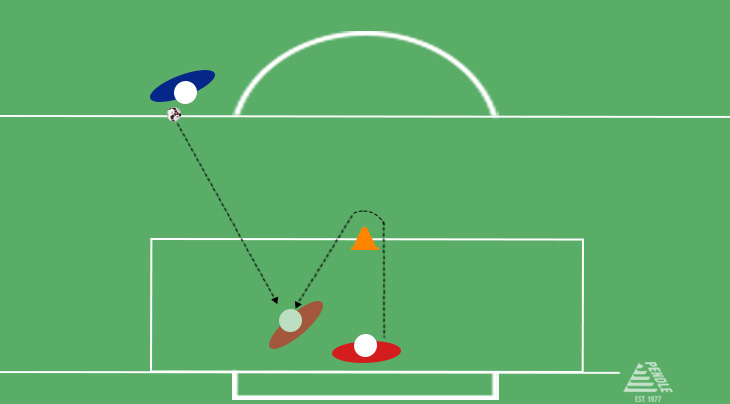
One Cone Drill
Equipment: One cone, footballs, and a goal.
Set-Up: Place a cone in the centre of the goal line. A server stands in the corner of the penalty area.
Instructions:
- The goalkeeper starts in the centre of the goal.
- They run to the cone as if closing down an opponent.
- The keeper runs round the cone and the server takes a shot. The keeper must stop the ball.
Coaching Points:
- When going around the cone, the keeper should be facing the direction the ball will be travelling.
- The keeper should be looking to change direction quickly.
- They need to keep their eyes on the ball and be ready to stop the shot.
Progression:
- Introduce a second shooter
- Decrease the time between shots, so the keeper has to think quickly.
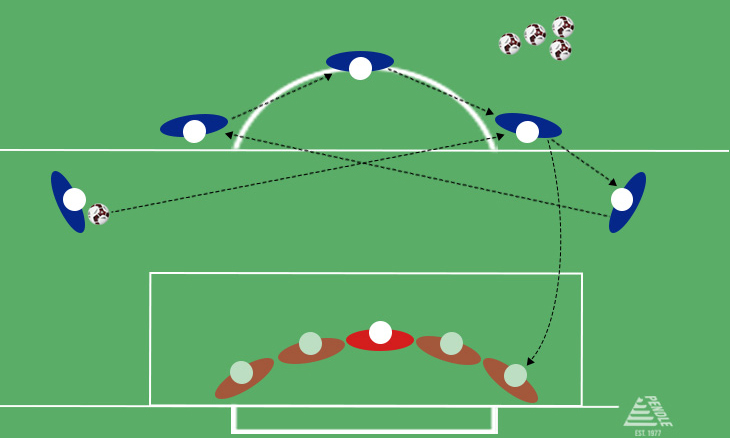
Follow the Ball
Equipment: Footballs and a goal.
Set-Up: The goalkeeper stands in the goal with 3-5 players spread out around the top of the penalty area. Give one of the players a ball and keep a supply of spares behind them.
Instructions:
- The players pass the ball between each other.
- Keeping their eye on the ball, the keeper follows it and adjusts their position accordingly.
- After four passes, any player can take a shot. The ball is passed around until somebody takes a shot at the goal.
- The keeper must save the ball.
- The players then start passing another ball as the keeper gets back up.
- Keep going for 4-6 reps before taking a break. Switch the keeper out for additional goalies if you have them.
- Each keeper should finish 2 or 3 sets.
Coaching Points:
- The keeper should always check their position and focus on proper footwork.
- The keeper must keep their eye on the ball and recover quickly after they save the ball.
- Encourage the players to pass quickly and be creative with their decisions. This will give the keeper more of a challenge.
Progression:
- The players with the ball must complete their passes and shot in one-touch, so the goalkeeper has less time to move and react.
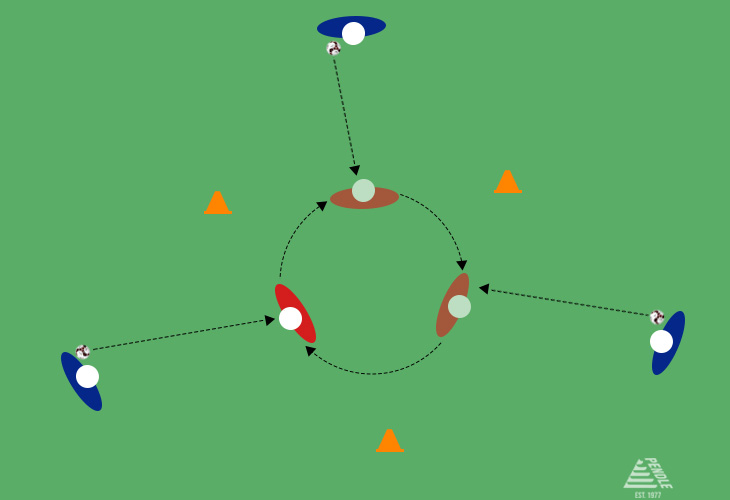
Three-Sided Goal
Equipment: Footballs, three flags/cones.
Set-Up: Divide players into teams of four (1 goalkeeper and 3 shooters). Set the flags or cones in a triangle about 25 feet apart. The players should stand about 50 feet away from the triangle with one standing opposite each side.
Instructions:
- The goalkeeper moves to each side of the triangular goal.
- Each shooter has to score but they can choose to shoot or dribble the ball.
- Once the keeper has saved the ball, they move to the next side.
- The next shooter should act once the keeper has had time to recover and position themselves correctly.
- The keeper should go to each player twice before taking a break.
Coaching Points:
- The shooters shouldn’t be focused on scoring but on helping the keeper develop.
- Ensure the keeper moves quickly between the flags so they have time to get into position.
- The keeper should determine how far to move off the goal line when facing up to the shooter.
Progression:
- Give less time for the goalkeeper to prepare between shots. They must move quickly between the sides and get into position.
- Give the shooters a number and choose one at random to take the next shot. The keeper must move into position to face this specific attacker instead of following a sequence.
Ready for the Pitch
The above drills are just a few examples of what you can do to prepare your keeper for the pitch. Effective goalkeeper training requires a variety of drills that cover a range of skills. As with all positions, your goalkeeper training should revolve around repetition and dedication, so keep the training focused and engaging.
Once your goalkeeper training is in full swing, you’ll want to ensure your goalies look the part. Our goalkeeper kits are available in various colourways that are guaranteed to stand out on the pitch. Browse our different designs and get your number 1 kitted out.
Resources:
- Alan Hargreaves and Richard Bate, (2010) Skills and Strategies For Coaching Soccer, 2nd Edition, Human Kinetics

